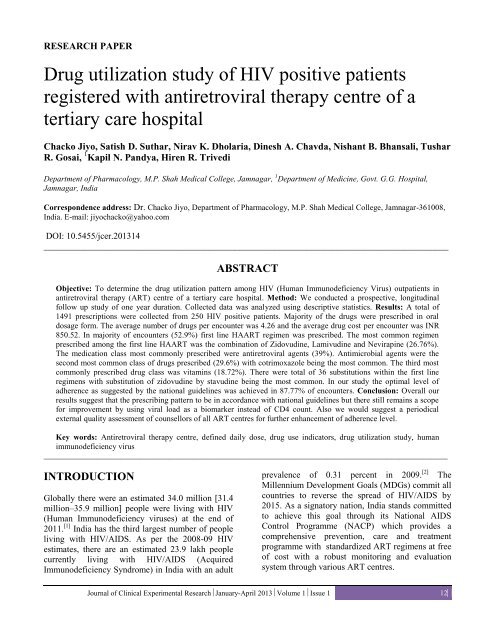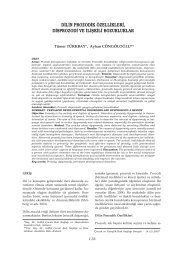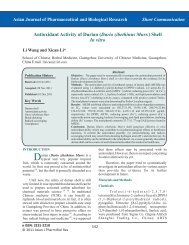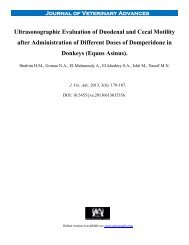Drug utilization study of HIV positive patients ... - eJManager.com
Drug utilization study of HIV positive patients ... - eJManager.com
Drug utilization study of HIV positive patients ... - eJManager.com
Create successful ePaper yourself
Turn your PDF publications into a flip-book with our unique Google optimized e-Paper software.
RESEARCH PAPER<br />
<strong>Drug</strong> <strong>utilization</strong> <strong>study</strong> <strong>of</strong> <strong>HIV</strong> <strong>positive</strong> <strong>patients</strong><br />
registered with antiretroviral therapy centre <strong>of</strong> a<br />
tertiary care hospital<br />
Chacko Jiyo, Satish D. Suthar, Nirav K. Dholaria, Dinesh A. Chavda, Nishant B. Bhansali, Tushar<br />
R. Gosai, 1 Kapil N. Pandya, Hiren R. Trivedi<br />
Department <strong>of</strong> Pharmacology, M.P. Shah Medical College, Jamnagar, 1 Department <strong>of</strong> Medicine, Govt. G.G. Hospital,<br />
Jamnagar, India<br />
Correspondence address: Dr. Chacko Jiyo, Department <strong>of</strong> Pharmacology, M.P. Shah Medical College, Jamnagar-361008,<br />
India. E-mail: jiyochacko@yahoo.<strong>com</strong><br />
DOI: 10.5455/jcer.201314<br />
___________________________________________________________________________________________<br />
ABSTRACT<br />
Objective: To determine the drug <strong>utilization</strong> pattern among <strong>HIV</strong> (Human Immunodeficiency Virus) out<strong>patients</strong> in<br />
antiretroviral therapy (ART) centre <strong>of</strong> a tertiary care hospital. Method: We conducted a prospective, longitudinal<br />
follow up <strong>study</strong> <strong>of</strong> one year duration. Collected data was analyzed using descriptive statistics. Results: A total <strong>of</strong><br />
1491 prescriptions were collected from 250 <strong>HIV</strong> <strong>positive</strong> <strong>patients</strong>. Majority <strong>of</strong> the drugs were prescribed in oral<br />
dosage form. The average number <strong>of</strong> drugs per encounter was 4.26 and the average drug cost per encounter was INR<br />
850.52. In majority <strong>of</strong> encounters (52.9%) first line HAART regimen was prescribed. The most <strong>com</strong>mon regimen<br />
prescribed among the first line HAART was the <strong>com</strong>bination <strong>of</strong> Zidovudine, Lamivudine and Nevirapine (26.76%).<br />
The medication class most <strong>com</strong>monly prescribed were antiretroviral agents (39%). Antimicrobial agents were the<br />
second most <strong>com</strong>mon class <strong>of</strong> drugs prescribed (29.6%) with cotrimoxazole being the most <strong>com</strong>mon. The third most<br />
<strong>com</strong>monly prescribed drug class was vitamins (18.72%). There were total <strong>of</strong> 36 substitutions within the first line<br />
regimens with substitution <strong>of</strong> zidovudine by stavudine being the most <strong>com</strong>mon. In our <strong>study</strong> the optimal level <strong>of</strong><br />
adherence as suggested by the national guidelines was achieved in 87.77% <strong>of</strong> encounters. Conclusion: Overall our<br />
results suggest that the prescribing pattern to be in accordance with national guidelines but there still remains a scope<br />
for improvement by using viral load as a biomarker instead <strong>of</strong> CD4 count. Also we would suggest a periodical<br />
external quality assessment <strong>of</strong> counsellors <strong>of</strong> all ART centres for further enhancement <strong>of</strong> adherence level.<br />
Key words: Antiretroviral therapy centre, defined daily dose, drug use indicators, drug <strong>utilization</strong> <strong>study</strong>, human<br />
immunodeficiency virus<br />
____________________________________________________________________________________________________<br />
INTRODUCTION<br />
Globally there were an estimated 34.0 million [31.4<br />
million–35.9 million] people were living with <strong>HIV</strong><br />
(Human Immunodeficiency viruses) at the end <strong>of</strong><br />
2011. [1] India has the third largest number <strong>of</strong> people<br />
living with <strong>HIV</strong>/AIDS. As per the 2008-09 <strong>HIV</strong><br />
estimates, there are an estimated 23.9 lakh people<br />
currently living with <strong>HIV</strong>/AIDS (Acquired<br />
Immunodeficiency Syndrome) in India with an adult<br />
prevalence <strong>of</strong> 0.31 percent in 2009. [2] The<br />
Millennium Development Goals (MDGs) <strong>com</strong>mit all<br />
countries to reverse the spread <strong>of</strong> <strong>HIV</strong>/AIDS by<br />
2015. As a signatory nation, India stands <strong>com</strong>mitted<br />
to achieve this goal through its National AIDS<br />
Control Programme (NACP) which provides a<br />
<strong>com</strong>prehensive prevention, care and treatment<br />
programme with standardized ART regimens at free<br />
<strong>of</strong> cost with a robust monitoring and evaluation<br />
system through various ART centres.<br />
Journal <strong>of</strong> Clinical Experimental ResearchJanuary-April 2013Volume 1Issue 1 12
Jiyo, et al.: <strong>Drug</strong> <strong>utilization</strong> <strong>study</strong> in antiretroviral therapy centre<br />
<strong>HIV</strong> is the initial causative agents in AIDS but most<br />
<strong>of</strong> the morbidity and mortality in AIDS cases result<br />
from opportunistic infections which necessitates<br />
polypharmacy. In addition to this high burden <strong>of</strong> the<br />
disease and lack <strong>of</strong> funds especially in developing<br />
countries, we conducted this <strong>study</strong> to determine the<br />
drug use indicators, adherence and oppurtunistic<br />
infections among <strong>HIV</strong> <strong>positive</strong> <strong>patients</strong> attending<br />
ART (Anti Retroviral Therapy) centre <strong>of</strong> a<br />
Government tertiary care hospital. The data thus<br />
obtained would give feedback to clinicians and the<br />
health care decision makers regarding <strong>com</strong>pliance <strong>of</strong><br />
the treatment <strong>of</strong>fered with regard to the national<br />
guidelines and thus promoting rational drug use.<br />
MATERIALS AND METHODS<br />
This was an observational, prospective, longitudinal<br />
follow up <strong>study</strong> conducted over a period <strong>of</strong> one year<br />
(January 2010 to December 2010) after approval<br />
from Institutional Ethics Committee, Shree M. P.<br />
Shah Medical College and Govt. G. G. Hospital,<br />
Jamnagar. Based on WHO (World Health<br />
Organisation) re<strong>com</strong>mendations for sample size in<br />
drug <strong>utilization</strong> studies, we used a sample consisting<br />
<strong>of</strong> 250 <strong>patients</strong> having 1491 encounters.<br />
All newly registered <strong>HIV</strong> <strong>positive</strong> <strong>patients</strong> registered<br />
with ART centre <strong>of</strong> our institute including all age<br />
groups <strong>of</strong> both sex including pregnant females and<br />
lactating mothers were included. At each encounter,<br />
after consultation by the treating physician, written<br />
informed consent was obtained and the <strong>patients</strong> were<br />
interviewed to get detailed information about their<br />
clinical status including opportunistic infections,<br />
drugs prescribed, adherence to therapy and possible<br />
adverse effects in the previous encounter. Adherence<br />
was checked by asking the patient if he/she had<br />
missed any doses and by counter checking the bottle<br />
containing anti retroviral drugs as per national<br />
guidelines. The level <strong>of</strong> adherence was estimated at<br />
the end <strong>of</strong> 30 days <strong>of</strong> treatment and was reported as<br />
>95% (less than 3 doses missed), 80-95% (3-12<br />
doses missed), 12 doses missed).<br />
The data so collected was analysed using descriptive<br />
statistics to determine drug use indicators and<br />
<strong>utilization</strong> pattern <strong>of</strong> drugs in <strong>HIV</strong> <strong>positive</strong> <strong>patients</strong>.<br />
RESULTS<br />
A total <strong>of</strong> 1491 prescriptions were collected from<br />
250 <strong>HIV</strong> <strong>positive</strong> <strong>patients</strong> out which majority<br />
(75.6%) belonged to the age group <strong>of</strong> 20-40 years.<br />
Prevalence was higher in males (62.8%) <strong>com</strong>pared<br />
to females (37.2%). Majority (80%) <strong>of</strong> the <strong>patients</strong><br />
had being diagnosed <strong>HIV</strong> <strong>positive</strong> for last 2 years.<br />
130 (52%) were receiving HAART (High Active<br />
Anti Retroviral Therapy) and the rest 120 (48%)<br />
remained naive. Among the <strong>patients</strong> on HAART,<br />
57.6% were receiving HAART regimens for last one<br />
year. Demographic characteristics <strong>of</strong> <strong>patients</strong> are<br />
summarized in Table 1.<br />
Table 1: Demographic characteristic <strong>of</strong> <strong>patients</strong><br />
Characteristics<br />
No. <strong>of</strong> <strong>patients</strong><br />
(n=250)<br />
Age (years)<br />
Range 2-72<br />
Mean age ± SD 31.49 ± 15<br />
Sex<br />
Male 157 (62.8%)<br />
Female 93(37.2%)<br />
Duration since diagnosed<br />
<strong>HIV</strong> <strong>positive</strong> (years)<br />
≤2 200 (80%)<br />
2-4 34 (13.6%)<br />
> 4 16 (6.4%)<br />
Patients receiving HAART 130 (52%)<br />
Patients not receiving HAART 120 (48%)<br />
Treatment duration with HAART (years)<br />
≤1 75 (57.6%)<br />
>1 55 (42.4%)<br />
The average number <strong>of</strong> drugs per encounter was 4.26<br />
with range <strong>of</strong> 0 to 12. In majority <strong>of</strong> encounters<br />
(60.54%) four or more drugs were prescribed. The<br />
average number <strong>of</strong> drugs prescribed to <strong>patients</strong> with<br />
duration <strong>of</strong> illness less than or equal to 1 year was<br />
3.69, in <strong>com</strong>parison to 4.81 and 4.41 among <strong>patients</strong><br />
having duration <strong>of</strong> 1 to 2 years and greater than 2<br />
years respectively. WHO specified drug use<br />
indicators are given in Table 2.<br />
In majority <strong>of</strong> encounters (52.9%) first line HAART<br />
regimen was prescribed. The most <strong>com</strong>mon regimen<br />
prescribed among the first line HAART was the<br />
<strong>com</strong>bination <strong>of</strong> Zidovudine, Lamivudine and<br />
Nevirapine (26.76%) followed by Stavudine,<br />
Lamivudine and Nevirapine (10.53%) [Table 3]. The<br />
medications class most <strong>com</strong>monly prescribed were<br />
antiretroviral agents (39%), with nucleoside reverse<br />
transcriptase inhibitors (NRTIs) (25.96%), nonnucleoside<br />
reverse transcriptase inhibitors (NNRTIs)<br />
Journal <strong>of</strong> Clinical & Experimental ResearchJanuary-April 2013Volume 1Issue 1 13
Jiyo, et al.: <strong>Drug</strong> <strong>utilization</strong> <strong>study</strong> in antiretroviral therapy centre<br />
(12.14%), protease inhibitors (PIs) (0.90%). Among<br />
antiretroviral agents, the most <strong>com</strong>monly prescribed<br />
NRTIs, NNRTIs, PIs were lamivudine (12.87%),<br />
nevirapine (8.62%), lopinavir/ritonavir (0.91%)<br />
respectively. Antimicrobial agents were the second<br />
most <strong>com</strong>mon class <strong>of</strong> drugs prescribed (29.6%).<br />
The most <strong>com</strong>mon antibacterial agent used was<br />
cotrimoxazole (18.58%), followed by<br />
antimycobacterial agents (9.3%). The third most<br />
<strong>com</strong>monly prescribed drug class in our <strong>study</strong> was<br />
vitamins namely folic acid and vitamin B <strong>com</strong>plex<br />
tablets (18.72%) followed by ferrous sulphate<br />
(9.36%). The other less <strong>com</strong>monly used drugs<br />
included as miscellaneous were paracetamol (0.8%),<br />
chlorpheniramine (0.62%), ibupr<strong>of</strong>en (0.58%),<br />
ranitide (0.36%), calamine lotion (0.12%),<br />
antihypertensives (0.09%), antidiabetic agents<br />
(0.06%), bronchodilators (0.04%), albendazole<br />
(0.01%), gamma benzene hexachoride (0.01%) and<br />
valproate (0.01%) [Table 4].<br />
Table 2: Details on drug use indicators<br />
Core indicators<br />
Prescribing Indicators<br />
Average drugs prescribed 4.26<br />
% <strong>of</strong> drug prescribed by generic names 81.42%<br />
% <strong>of</strong> encounters with an antibiotic prescribed 79.54%<br />
% <strong>of</strong> encounters with an injection prescribed 0.47%<br />
% <strong>of</strong> drug from essential drug list 86.04%<br />
Patient care indicators<br />
Average consulting time (min) 10.35<br />
Average dispensing time (sec) 19.14<br />
% <strong>of</strong> drugs dispensed 93.18%<br />
Patient knowledge <strong>of</strong> correct dosage 87.46%<br />
Facility indicators<br />
Availability <strong>of</strong> essential medicine list or formulary Yes<br />
Key drugs available 88.63%<br />
Complementary indicators<br />
% <strong>of</strong> encounters treated without drugs 13.74%<br />
Average drug cost per prescription (INR) 850.52<br />
<strong>Drug</strong> cost on injections 6.38%<br />
The first line regimens prescribed at the time <strong>of</strong><br />
initiation <strong>of</strong> antiretroviral treatment were Zidovudine<br />
+ Lamivudine + Nevirapine (56.16%), Zidovudine +<br />
Lamivudine+ Efavirenz (23%), Stavudine +<br />
Lamivudine + Nevirapine (12.3%) and Stavudine +<br />
Lamivudine + Efavirenz (7.69%). Since start <strong>of</strong><br />
HAART, 98% <strong>patients</strong> had their CD4 count greater<br />
than 50% <strong>of</strong> the peak. There were total <strong>of</strong> 36<br />
substitutions within the first line regimens with<br />
substitution <strong>of</strong> zidovudine by stavudine being the<br />
most <strong>com</strong>mon. Anemia was the most <strong>com</strong>mon<br />
reason for substitution [Table 5].<br />
Table 3: Utilization pattern <strong>of</strong> different<br />
HAART regimens<br />
HAART regimen<br />
First line<br />
Zidovudine + Lamivudine +<br />
Nevirapine<br />
Zidovudine + Lamivudine +<br />
Efavirenz<br />
Stavudine + Lamivudine +<br />
Nevirapine<br />
Stavudine + Lamivudine +<br />
Efavirenz<br />
Second line<br />
Zidovudine + Lamivudine +<br />
Ten<strong>of</strong>ovir + Lopinavir/ritonavir<br />
boosted<br />
No. (percentage <strong>of</strong><br />
encounters; n=1491)<br />
399 (26.76)<br />
158 (10.6)<br />
157 (10.53)<br />
75 (5.03)<br />
14 (0.94)<br />
Lamivudine + Ten<strong>of</strong>ovir +<br />
Lopinavir/ritonavir boosted 15 (1)<br />
Table 4: <strong>Drug</strong> groups used in <strong>HIV</strong> <strong>positive</strong><br />
<strong>patients</strong> at our ART centre on outpatient basis<br />
No. (percentage <strong>of</strong><br />
<strong>Drug</strong>s<br />
drugs prescribed;<br />
n=6354)<br />
Antiretroviral agents<br />
NRTIs 1650 (25.96)<br />
Zidovudine 575 (9.04)<br />
Stavudine 228 (3.58)<br />
Lamivudine 818 (12.87)<br />
Ten<strong>of</strong>ovir 29 (0.45)<br />
NNRTIs 772 (12.14)<br />
Nevirapine 548 (8.62)<br />
Efavirenz 224 (3.52)<br />
PIs<br />
Lopinavir/ ritonavir 58 (0.91)<br />
Antimicrobial agents<br />
Antibiotic agents 1266 (19.92)<br />
Cotrimoxazole 1181(18.58)<br />
Amoxicillin+Clavulanic acid 19 (0.3)<br />
Azithromycin 10 (0.15)<br />
Lev<strong>of</strong>loxacin 24 (0.3)<br />
Cipr<strong>of</strong>loxacin 22 (0.3)<br />
Silver sulfadiazine cream 10 (0.15)<br />
Antimycobacterial agents 592 (9.3)<br />
Isoniazid 198 (3.11)<br />
Rifampin 198 (3.11)<br />
Pyrazinamide 77 (1.21)<br />
Ethambutol 113 (1.77)<br />
Streptomycin 6 (0.09)<br />
Antiprotozoal agents 29 (0.45)<br />
Metronidazole 23 (0.36)<br />
Nitazoxamide 6 (0.09)<br />
Acyclovir 16 (0.25)<br />
Antifungal agents 11 (0.17)<br />
Fluconazole 9 (0.14)<br />
Clotrimazole cream 2 (0.03)<br />
Folic acid and Vitamin B <strong>com</strong>plex 1190 (18.7)<br />
Ferrous sulphate<br />
Miscellaneous<br />
595 (9.3)<br />
175 (2.7)<br />
Journal <strong>of</strong> Clinical & Experimental ResearchJanuary-April 2013Volume 1Issue 1 14
Jiyo, et al.: <strong>Drug</strong> <strong>utilization</strong> <strong>study</strong> in antiretroviral therapy centre<br />
Table 5: Substitution within first line HAART regimen<br />
HAART Regimen<br />
Substitution<br />
No. (percentage <strong>of</strong> encounters<br />
with substitutions; n=36)<br />
Zidovudine to Stavudine<br />
ZLN to SLN 14 (38.89)<br />
ZLE to SLE 4 (11.11)<br />
Nevirapine to Efavirenz<br />
SLN to SLE 8 (22.22)<br />
ZLN to ZLE 4 (11.11)<br />
Efavirenz to Nevirapine<br />
ZLE to ZLN 4 (11.11)<br />
SLE to SLN 2 (5.56)<br />
Reason for substitution<br />
Anemia<br />
Starting antituberculosis drugs/ nevirapine induced hepatotoxicity<br />
Completion <strong>of</strong> tuberculosis treatment<br />
In our <strong>study</strong> the level <strong>of</strong> adherence >95% which is<br />
considered optimal according to national guidelines<br />
was achieved in 87.77% <strong>of</strong> encounters. In 6.35% and<br />
5.13% <strong>of</strong> encounters the level <strong>of</strong> adherence was 80-<br />
95% and < 80% respectively. In 0.75% encounters<br />
the bottle was not brought by patient hence<br />
adherence could not be estimated. Tuberculosis was<br />
the most <strong>com</strong>mon opportunistic infection [Table 6].<br />
Table 6: Occurrences <strong>of</strong> opportunistic<br />
infections among <strong>HIV</strong> <strong>positive</strong> <strong>patients</strong><br />
Opportunistic infections Incidence (%)<br />
Tuberculosis 36 (26.86)<br />
Upper Respiratory infections 27 (20.15)<br />
Diarrhoea 21 (15.67)<br />
Skin infections (boils) 10 (7.46)<br />
Genital herpes 9 (6.72)<br />
Candidiasis 8 (5.97)<br />
Herpes zoster 7 (5.22)<br />
Lymphadenopathy 5 (3.73)<br />
Lower respiratory tract infections 3 (2.24)<br />
Parotitis 2 (1.49)<br />
Molluscum contagiosum 2 (1.49)<br />
Kaposis carcinoma 1 (0.75)<br />
Fungal skin infections 1 (0.75)<br />
Pnuemocystitis carinii pneumonia 1 (0.75)<br />
Scabies 1 (0.75)<br />
DISCUSSION<br />
<strong>HIV</strong> has been a growing challenge worldwide.<br />
Increase in our understanding <strong>of</strong> molecular biology<br />
and pathogenesis <strong>of</strong> the disease has led to the<br />
development <strong>of</strong> a number <strong>of</strong> new antiretroviral drugs<br />
and treatment protocols which has changed the<br />
world’s outlook on <strong>HIV</strong>/AIDS from a “virtual death<br />
sentence” to a “chronic manageable disease”. This<br />
<strong>study</strong> is a pharmacoepidemiological research on the<br />
<strong>utilization</strong> <strong>of</strong> antiretroviral agents in real life<br />
conditions for identifying discrepancies between<br />
their actual use and our national guidelines which<br />
are based on clinical trials. This will promote<br />
rational use <strong>of</strong> drugs.<br />
The (mean ± SD) age <strong>of</strong> the <strong>patients</strong> was 31.49 ± 15<br />
years with a range between 2 and 72 years. This<br />
higher prevalence <strong>of</strong> <strong>HIV</strong> among the sexually active<br />
and economically productive age group <strong>of</strong> 20-40<br />
years is in accordance with other studies from<br />
India [3] and abroad. [4]<br />
Prevalence was higher in males (62.8%) <strong>com</strong>pared to<br />
females (37.2%) which is in consonance with other<br />
Indian studies. [3]<br />
Majority <strong>of</strong> the <strong>patients</strong> had being suffering from<br />
<strong>HIV</strong> since at last 2 years [Table 1]. The mean<br />
duration was 20.1 ± 19 months with a range <strong>of</strong> 8<br />
months to 97 months. 52% were eligible for initiation<br />
<strong>of</strong> HAART which is in consonance with another<br />
pharmacoepidemiological <strong>study</strong>. [5]<br />
The average number <strong>of</strong> drugs per encounter was 4.26<br />
in our <strong>study</strong> with range <strong>of</strong> 0 to 12 [Table 2]. Our<br />
results are in accordance with a similar <strong>study</strong> which<br />
analysed 967 encounters <strong>of</strong> <strong>HIV</strong> infected out<strong>patients</strong><br />
<strong>patients</strong> and found average number <strong>of</strong> drugs per<br />
encounter to be 4.5. [5] Moreover as <strong>HIV</strong> is associated<br />
with various opportunistic infections, poly-pharmacy<br />
is quite relevant leading to high average number <strong>of</strong><br />
drugs prescribed. In 79.54% encounters an antibiotic<br />
was prescribed. Our results are in conformity with<br />
[5, 6, 7]<br />
other studies. It is clearly evident that the<br />
higher percentage <strong>of</strong> drugs prescribed by generic<br />
name and from essential drug list <strong>of</strong> WHO Model<br />
List <strong>of</strong> Essential Medicines for Adults, March 2011<br />
point towards rational therapeutics. 0.47% <strong>of</strong><br />
encounters with an injection prescribed were due to<br />
prescribing <strong>of</strong> the aminoglycoside streptomycin as<br />
part <strong>of</strong> tuberculosis treatment. In our <strong>study</strong> the<br />
higher percentage <strong>of</strong> <strong>patients</strong> having adequate<br />
Journal <strong>of</strong> Clinical & Experimental ResearchJanuary-April 2013Volume 1Issue 1 15
Jiyo, et al.: <strong>Drug</strong> <strong>utilization</strong> <strong>study</strong> in antiretroviral therapy centre<br />
knowledge <strong>of</strong> correct dosage schedule is suggestive<br />
<strong>of</strong> increasing awareness and better <strong>com</strong>pliance<br />
among <strong>HIV</strong> <strong>patients</strong> during past years. The<br />
availability <strong>of</strong> essential drug list is a better facility<br />
indicator <strong>of</strong> drug usage. Cost <strong>of</strong> prescription is<br />
important in chronic disease like <strong>HIV</strong> where drug<br />
has to be continued for life time. Average drug cost<br />
per encounter was 850.52 Indian National Rupees<br />
(INR) [Table 2]. The average annual cost <strong>of</strong><br />
antiretroviral drugs in our <strong>study</strong> <strong>com</strong>es to 16,524.96<br />
INR which is <strong>com</strong>parable to a <strong>study</strong> from South<br />
India in which the median annual costs <strong>of</strong> treatment<br />
for AIDS <strong>patients</strong> to be INR 17,606 with ARV. [9]<br />
The limitation <strong>of</strong> our <strong>study</strong> in calculating cost is that<br />
expenses incurred due to other than drugs were not<br />
considered.<br />
The defined daily dose (DDD) is the assumed<br />
average maintenance dose per day for a drug used<br />
for its main indication in adults. Using DDDs<br />
enables <strong>com</strong>parison to be made between drug groups<br />
as the influences <strong>of</strong> prescribing culture and available<br />
dosage strengths are eliminated. This estimate is<br />
most useful for chronically used drugs. [10]<br />
DDD/1000 inhabitant/day <strong>of</strong> antiretroviral drugs<br />
prescribed could not be calculated as WHO has not<br />
assigned DDD for fixed dose <strong>com</strong>binations <strong>of</strong><br />
antiretroviral drugs.<br />
In majority <strong>of</strong> encounters (52.9%) first line HAART<br />
regimen was prescribed. The most <strong>com</strong>mon regimen<br />
prescribed among the first line HAART was the<br />
<strong>com</strong>bination <strong>of</strong> Zidovudine, Lamivudine and<br />
Nevirapine (ZLN) (26.76%) followed by Stavudine,<br />
Lamivudine and Nevirapine (10.53%) (SLN) [Table<br />
3]. The above finding is in accordance with our<br />
national guidelines for antiretroviral therapy which<br />
re<strong>com</strong>mends ZLN as the first choice and SLN as<br />
second choice among all first line HAART<br />
regimens. Our results differ from a <strong>study</strong> done at<br />
Columbia in which the most <strong>com</strong>mon <strong>com</strong>binations<br />
prescribed were ZLE (35%), ZL+L/r (8.4%), ZLA<br />
(5.5%), ZLN (5.2%). [11] Another similar<br />
observational <strong>study</strong> from Asia found the<br />
<strong>com</strong>binations like SLN (37%), ZLE (13%), ZLN<br />
(9%), SLE (9%) were <strong>com</strong>monly prescribed. [12] This<br />
difference in prescribing rates <strong>of</strong> various regimens<br />
may be due to difference between the guidelines for<br />
antiretroviral therapy in various countries.<br />
The medications class most <strong>com</strong>monly prescribed<br />
were antiretroviral agents (39%), with nucleoside<br />
reverse transcriptase inhibitors (25.96%), nonnucleoside<br />
reverse transcriptase inhibitors (12.14%),<br />
protease inhibitors (0.90%). All the doses were at<br />
re<strong>com</strong>mended levels and majority <strong>of</strong> drugs were<br />
prescribed in oral dosage forms. Our results are in<br />
consonance with other studies in which majority <strong>of</strong><br />
<strong>patients</strong> were prescribed nucleoside reverse<br />
transcriptase inhibitors followed by non nucleoside<br />
reverse transcriptase inhibitors and protease<br />
[4, 11]<br />
inhibitor. In consonance with another <strong>study</strong><br />
among antiretroviral agents, the most <strong>com</strong>monly<br />
prescribed NRTIs, NNRTIs, PIs were lamivudine<br />
(32.98%), nevirapine (22.09%), lopinavir/ritonavir<br />
(2.33%) respectively [Table 4]. [13] Antibacterial<br />
agents were the second most <strong>com</strong>mon class <strong>of</strong> drugs<br />
prescribed (29.6%) which is in consonance with<br />
other studies. [14] The most <strong>com</strong>mon antibacterial<br />
agent used was cotrimoxazole (18.58%), followed<br />
by antimycobacterial agents (9.3%). A similar type<br />
<strong>of</strong> <strong>study</strong> from Switzerland found cotrimoxazole to be<br />
[5, 7]<br />
the most <strong>com</strong>mon antibiotic being used. The<br />
increased use <strong>of</strong> cotrimoxazole is justifiable as it is<br />
re<strong>com</strong>mended for chemoprophylaxsis against<br />
pnuemocystitis carinii pnuemonia. Given the high<br />
rates <strong>of</strong> TB-<strong>HIV</strong> co-infection in our <strong>study</strong>, increased<br />
use <strong>of</strong> antimycobacterial agents is also justifiable.<br />
Like prior studies, the third most <strong>com</strong>monly<br />
prescribed drug class in our <strong>study</strong> was vitamins<br />
namely folic acid and vitamin B <strong>com</strong>plex tablets<br />
(18.72%) followed by ferrous sulphate (9.36%)<br />
[Table 4]. [14]<br />
In our <strong>study</strong> the most <strong>com</strong>monly prescribed HAART<br />
regimen at initiation <strong>of</strong> antiretroviral treatment was<br />
Zidovudine + Lamivudine + Nevirapine (56.16%).<br />
This is in accordance to our national guidelines for<br />
starting HAART in <strong>HIV</strong> <strong>positive</strong> <strong>patients</strong>. The<br />
Stavudine based regimens were less preferred at<br />
initiation due to its toxicity pr<strong>of</strong>ile. The second most<br />
<strong>com</strong>mon regimen prescribed at start was Zidovudine<br />
+ Lamivudine+ Efavirenz (23%) which might be due<br />
to concurrent occurrence <strong>of</strong> tuberculosis. There were<br />
total <strong>of</strong> 36 substitutions within the first line regimens<br />
with substitution <strong>of</strong> zidovudine by stavudine being<br />
the most <strong>com</strong>mon [Table 5]. Our results differ from<br />
a <strong>study</strong> in South Africa where substitution <strong>of</strong><br />
Stavudine with Zidovudine (38%) was the most<br />
<strong>com</strong>mon. [15] This variation might be due to<br />
difference in the pattern <strong>of</strong> drug usage. National<br />
guidelines re<strong>com</strong>mend the usage <strong>of</strong> Zidovudine<br />
Journal <strong>of</strong> Clinical & Experimental ResearchJanuary-April 2013Volume 1Issue 1 16
Jiyo, et al.: <strong>Drug</strong> <strong>utilization</strong> <strong>study</strong> in antiretroviral therapy centre<br />
http://www.unaids.org/en/media/unaids/contentassets<br />
/documents/epidemiology/2012/gr2012/20121120_U<br />
NAIDS_Global_Report_2012_en.pdf [Last accessed<br />
on 2012 Dec 28].<br />
2. National AIDS Control Organization, Govt <strong>of</strong> India,<br />
New Delhi. www.nacoonline.org [homepage<br />
on the Internet]. "Annual Report 2011-2012”.<br />
Available<br />
from:<br />
https://nacoonline.org/upload/Publication/Annual%2<br />
0Report/NACO_AR_Eng%202011-12.pdf [Last<br />
accessed on 2012 Dec 28].<br />
3. Khan MA, Sehgal A. Clinico-epidemiological and<br />
socio-behavioral <strong>study</strong> <strong>of</strong> people living with<br />
<strong>HIV</strong>/AIDS. Indian J Psychol Med 2010;32:22-8.<br />
4. Jimenez-Nacher I, García B, Barreiro P, Rodriguez-<br />
Novoa S, Morello J, Gonzalez-Lahoz J,et al. Trends<br />
in the prescription <strong>of</strong> antiretroviral drugs and impact<br />
on plasma <strong>HIV</strong>-RNA measurements. J. Antimicrob.<br />
Chemother 2008;62:816-22.<br />
5. Meister TH, Ledergerber B, Merk B, Opravil M,<br />
Luthy R. Pharmacoepidemiology and drug<br />
interactions in ambulatory <strong>HIV</strong>-<strong>positive</strong> <strong>patients</strong> with<br />
less than 100 CD4+ cells. Int Conf AIDS1996;11:87.<br />
6. Bjornson DC, Meyer DE, Hiner WO Jr, Tramont EC.<br />
Prescription drug use patterns <strong>of</strong> human<br />
immunodeficiency virus-infected <strong>patients</strong> taking<br />
zidovudine. Walter Reed Retrovirus Research Group.<br />
DICP 1989;23:698-702.<br />
7. Chow R, Chin T, Fong IW, Bendayan R. Medication<br />
use patterns in <strong>HIV</strong>-<strong>positive</strong> <strong>patients</strong>. Can J Hosp<br />
Pharm 1993;46:171-5.<br />
8. WHO Model List <strong>of</strong> Essential Medicines for Adults,<br />
March 2011. Available from:<br />
http://whqlibdoc.who.int/hq/2011/a95053_eng.pdf<br />
[Last accessed on 2012 Dec 29].<br />
9. John KR, Rajagopalan N, Madhuri KV. Economic<br />
<strong>com</strong>parison <strong>of</strong> opportunistic infection management<br />
with antiretroviral treatment in people living with<br />
<strong>HIV</strong>-AIDS presenting at an NGO clinic in Bangalore,<br />
India. Med Gen Med 2006;1:24.<br />
10. WHO, Introduction to <strong>Drug</strong> Utilization Research,<br />
World Health Organization, Oslo, Norway; 2003.<br />
http://www.whocc.no/filearchive/publications/drug_u<br />
tilization_research.pdf [Last accessed on 2012 May<br />
29].<br />
11. Machado JE, Alzate JA. Patterns <strong>of</strong> antiretroviral<br />
drug prescription in 997 Colombian <strong>patients</strong>.<br />
Biomedica 2008;28:78-86.<br />
12. Srasuebkul P, Calmy A, Zhou J, Kumarasamy N,<br />
Law M, Lim PL. Impact <strong>of</strong> drug classes and<br />
treatment availability on the rate <strong>of</strong> antiretroviral<br />
treatment change in the TREAT Asia <strong>HIV</strong><br />
Observational Database (TAHOD). AIDS Res Ther<br />
2007;4-18.<br />
13. Ghani AC, Donnelly CA, Anderson RM. Patterns <strong>of</strong><br />
antiretroviral use in the United States <strong>of</strong> America:<br />
analysis <strong>of</strong> three observational databases. <strong>HIV</strong> Med<br />
2003;4:24-32.<br />
14. Fogelman I, Lim L, Bassett R, Volberding P, Fischl<br />
MA, Stanley K, et al. Prevalence and patterns <strong>of</strong> use<br />
<strong>of</strong> con<strong>com</strong>itant medications among participants in<br />
three multicenter human immunodeficiency virus<br />
type I clinical trials. AIDS Clinical Trials Group<br />
(ACTG). J Acquir Immune Defic Syndr<br />
1994;7:1057-63.<br />
15. Sanne IM, Westreich D, Macphail AP, Rubel D,<br />
Majuba P, et al. Long-term out<strong>com</strong>es <strong>of</strong> antiretroviral<br />
therapy in a large <strong>HIV</strong>/AIDS care clinic in urban<br />
South Africa: a prospective cohort <strong>study</strong>. J Int AIDS<br />
Soc 2009;12-38.<br />
16. Cesar C, Shepherd BE, Krolewiecki AJ, Fink VI,<br />
Schechter M, et al. Rates and reasons for early<br />
change <strong>of</strong> first HAART in <strong>HIV</strong>-1-infected <strong>patients</strong> in<br />
7 Sites throughout the Caribbean and Latin America.<br />
PLoS ONE 2010;5(6):e10490.<br />
17. Kumarasamy N, Vallabhaneni S, Cecelia AJ, et al.<br />
Reasons for modification <strong>of</strong> generic highly active<br />
antiretroviral therapeutic regimens among <strong>patients</strong> in<br />
southern India. J Acquir Immune Defic Sydr<br />
2006;41:53-8.<br />
18. National AIDS Control Organization Ministry <strong>of</strong><br />
Health and Family Welfare Government <strong>of</strong> India,<br />
“National Aids Control Programme-India Care,<br />
Support & Treatment, June 2010”. Availabe from:<br />
http://nacoonline.org/upload/REPORTS/Monograph<br />
%20on%20<strong>HIV</strong>_CST%20division%20_21st%20June<br />
%202010.pdf [Last accessed on 2012 Dec 29].<br />
19. Sarna A, Pujari S, Sengar AK, Garg R, Gupta I, Dam<br />
J. Adherence to antiretroviral therapy & its<br />
determinants amongst <strong>HIV</strong> <strong>patients</strong> in India. Indian J<br />
Med Res 2008;127:28-36.<br />
20. Ukwe CV, Ekwunife OI, Udeogaranya OP, Iwuamadi<br />
UI. Self-reported adherence to HAART in South-<br />
Eastern Nigeria is related to <strong>patients</strong> use <strong>of</strong> pill box.<br />
SAHARA J: Journal <strong>of</strong> Social Aspects <strong>of</strong> <strong>HIV</strong>/AIDS<br />
Research Alliance / SAHARA, Human Sciences<br />
Research Council 2010;7:10-5.<br />
21. Segeral O, Madec Y, Ban B, Ouk V, Hak CR, Le<br />
Tiec C, et al. Simplified assessment <strong>of</strong> antiretroviral<br />
adherence and prediction <strong>of</strong> virological efficacy in<br />
<strong>HIV</strong>-infected <strong>patients</strong> in Cambodia. AIDS Res Treat<br />
2010;2010:142076. Epub 2009 Dec 31.<br />
22. Sharma SK, Dhooria S, Prasad KT, George N,<br />
Ranjan S, Gupta D, et al. Out<strong>com</strong>es <strong>of</strong> antiretroviral<br />
therapy in a northern Indian urban clinic. Bulletin <strong>of</strong><br />
the World Health Organization 2010;88:222-226.<br />
23. Kumarasamy N, Solomon S, Flanigan TP, Hemalatha<br />
R, Thyagarajan SP, Mayer KH. Natural history <strong>of</strong><br />
human immunodeficiency virus disease in southern<br />
India. Clin Inf Dis 2003;36:79-85.<br />
Journal <strong>of</strong> Clinical & Experimental ResearchJanuary-April 2013Volume 1Issue 1 18
Jiyo, et al.: <strong>Drug</strong> <strong>utilization</strong> <strong>study</strong> in antiretroviral therapy centre<br />
24. Singh A, Bairy I, Shivananda PG. Spectrum <strong>of</strong><br />
opportunistic infections in AIDS cases. Indian J Med<br />
Sci 2003;57:16-21.<br />
25. Misra SN, Sengupta D, Satpathy SK. AIDS in India:<br />
recent trends in opportunistic infections. Southeast<br />
Asian J Trop Med Public Health 1998;29: 373-6.<br />
26. Solomon S, Kumarasamy N, Anuradha S, Vennila R,<br />
Pal JA. TB and <strong>HIV</strong> infection - an association. Indian<br />
J Med Microbiol 1994;12:313-4.<br />
27. Ghate MV, Mehendale SM, Mahajan BA, Yadav R,<br />
Brahme RG, Divekar AD, et al. Relationship between<br />
clinical condition and CD4 cell counts in <strong>HIV</strong>infected<br />
persons, Pune, Maharashtra, India. Natl Med<br />
J India 2000;13:183-7.<br />
Cite this article as: Jiyo C, Suthar SD, Dholaria NK, Chavda DA,<br />
Bhansali NB, Gosai TR, et al. <strong>Drug</strong> <strong>utilization</strong> <strong>study</strong> <strong>of</strong> <strong>HIV</strong><br />
<strong>positive</strong> <strong>patients</strong> registered with antiretroviral therapy centre <strong>of</strong> a<br />
tertiary care hospital. J Clin Exp Res 2013;1:12-19.<br />
Source <strong>of</strong> Support: Nil, Conflicts <strong>of</strong> Interest: None declared<br />
Journal <strong>of</strong> Clinical & Experimental ResearchJanuary-April 2013Volume 1Issue 1 19
















